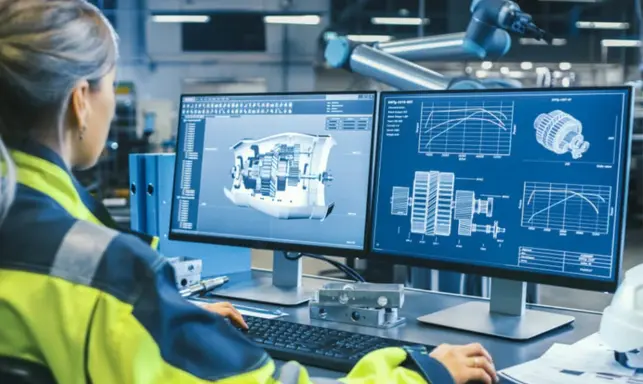In this article, we will discuss solid modeling, how solid model accuracy benefits manufacturing, its other benefits, common uses and everything else.
If you’re an engineer or anyone who builds any object, this article wouldn’t be a waste of your time. If anything, you’d probably end up saving some money, a lot of time and energy once you’re done here.
Let’s get started then!
Understanding solid modeling

I like to explain Solid Modeling as “the most realistic and detailed digital reproduction of an object”.
I say that because solid modeling aims to design objects with as much geometrical and mathematical accuracy as possible.
The interiors, volume, angles, holes, voids and everything else is as accurate as it needs to be for the object to achieve its desired function.dsaZ
3D solid modeling can also be put into simulations and tested for its reactions to different environments. You can simulate different build materials, heat transfers, tolerance, weight differences and many other real-life dynamics digitally before you finalize your product.
Other types of 3D designs include surface modeling or wireframe modeling. These focus primarily on the exterior of an object, or the edges. How they look and maybe the overall size. Unlike solid modeling, these designs can’t be “simulated” or tested as they’re mostly for “visual” references.
In simpler words, solid modeling is building a working product digitally that can later be built in the real-world.
Benefits of Solid Modeling in Manufacturing Accuracy
Solid Modeling has dozens of benefits but the way it impacts manufacturing accuracy definitely deserves a discussion:
- Accurate functioning verification: 3D modeling lets you test the actual working of the prototype before it goes into manufacturing. This almost guarantees that whatever you manufacture will work accurately.
- Perfect CAM instructions: CAM stands for Computer Aided Manufacturing. In simpler words, solid modeling can help you configure your manufacturing machine perfectly and more precisely so the final output is produced without flaws.
- Accurate assembly: You can assemble all the different parts of your object and ensure they fit each other, and the assembly line perfectly before actually sending to be manufactured.
These were just the benefits that bring in “accuracy”. In general, there’s a lot more solid modeling enables.
Impact on Manufacturing Processes
I believe solid modeling did to the manufacturing industry what the wheel did to mankind. I’ll tell you why:
- Reduced prototyping costs: Physical prototyping is expensive. It’s actually exponentially expensive when compared to digital 3D solid modeling. 3D modeling definitely helps reduce prototyping costs.
- More and faster design changes: 3D modeling allows you to change parts and shapes that don’t work faster and more frequently. You can make changes with physical prototypes as well but that would take way more time.
- Better communication: Given the digital medium, designers and engineers can explain the prototype, its parts and everything else better to their colleagues as compared to discussing a physical prototype.
- More innovation: Solid modeling allows you to try out the weirdest, most non-traditional/complex innovations that may not be time or budget-friendly to do with physical prototypes.
What are the most common uses of solid modeling?
I’m sure you’ve found the industries that would benefit massively from solid modeling. However, here are some more in case you’re curious:
- Engineering: Anyone who builds anything can start with solid modeling to save time, energy and even money.
- Architecture: Architectures can use it for structural analysis, load distribution, space utilization etc.
- Medical uses: the human body is extremely precise. This means anything that medical science puts into our bodies has to be accurate down to the micrometer.
- Entertainment: This may not be the best solid modeling use but solid modeling can still be used to design game characters and areas.
How to choose the best solid modeling software?
Like any other tool, there’s no “one size fits all” when it comes to solid modeling software. The best tool would depend on your exact needs, budget, industry and so on.
However, here a few pointers that should make your life easier:
- Budget/free vs. paid: No other feature would matter if the tool doesn’t fit your budget. Hence, start by looking at options that you can afford. While free options exist, they’d be rather limited in features and functionality and I’d advise against that.
- Industry: Not all solid modeling software fit all industries (architecture/medical/engineering etc.). Make sure the one you’re using is optimized or has the features your industry needs.
- Reviews: It’s best to go through reviews and ratings provided by others for the software you’re looking at.
- Learning curve: Some of these tools are easier to use than others. You may watch Youtube videos or tutorials to get an understanding of which tool fits your level of expertise or has an easier learning curve.
Conclusion
By now you should’ve got a decent idea about solid modeling as well as its benefits in manufacturing accuracy. Of course, the list of benefits apart from accuracy are impressive as well, wouldn’t you agree?
It’s the one technology that benefits nearly every industry out there as long as the industry is building something.
When you go about picking your software, make sure it’s something that has good reviews and all the features you seek. If possible, extend your budget a bit if you find the right tool. I say that because the right tool would ultimately pay off rather than getting a cheap/free tool that ultimately results in a bad render and net loss.
That’ll be all for now, I hope I’ve helped you understand how solid modeling improves accuracy in manufacturing.
